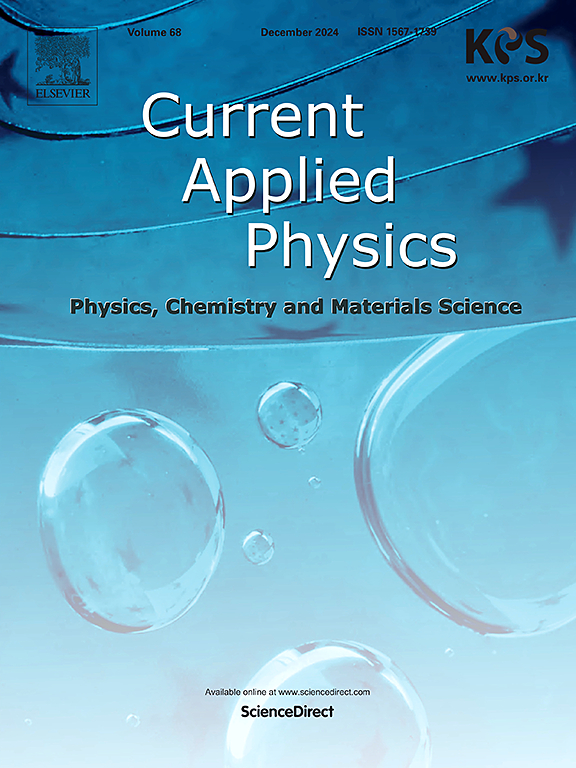MoS2增感锥形光纤倏逝波传感器在折射率葡萄糖传感中的应用
IF 3.1
4区 物理与天体物理
Q3 MATERIALS SCIENCE, MULTIDISCIPLINARY
引用次数: 0
摘要
本文提出了一种二维(2D)二硫化钼(MoS2)涂层锥形多模光纤传感器,并对其折射率传感特性进行了研究,用于葡萄糖监测。采用一种高效的化学蚀刻方法对多模光纤进行变细处理。在锥形区域涂覆二硫化钼纳米片,并采用低成本的液相剥离法合成。通过对异丙醇(IPA)和二甲基甲酰胺(DMF)溶剂沉积的比较,选择了理想的去角质溶剂。结果表明,DMF是合成二维二硫化钼纳米片的理想溶剂,也是在光纤衬底上沉积纳米片的理想溶剂。采用光沉积的方法将合成的二维二硫化钼与锥形光纤相结合。均匀多模光纤、锥形多模光纤和MoS2涂层锥形多模光纤传感器的灵敏度分别为25,297%和525% /RIU。mos2涂层的锥形光纤的灵敏度分别是均匀型和锥形光纤探头的1.7倍和21倍。在高灵敏度的同时,mos2涂层的锥形光纤传感器探头在1.33-1.41范围内的RI变化也具有很高的线性度。结果表明,该传感器可在400 ~ 1000nm的任意波长范围内工作。此外,我们认为所提出的传感器探针使用强度询问方法将成为健康监测的潜在候选,因为它具有高灵敏度、线性、可重复性和寿命。本文章由计算机程序翻译,如有差异,请以英文原文为准。

MoS2 sensitized tapered fiber optic evanescent wave sensor for refractive index based glucose sensing application
In this paper, a two-dimensional (2D) molybdenum disulfide (MoS2) coated tapered multimode optical fiber sensor is proposed and its characteristics of refractive index sensing are investigated for the application of glucose monitoring. An highly efficient chemical etching approach has been carried out for tapering the multimode optical fiber. The tapered region is coated with MoS2 nanosheets and they are synthesized by using a cost-effective liquid phase exfoliation [LPE] method. The ideal solvent for exfoliation has been chosen by comparing the deposition using isopropyl alcohol (IPA) and dimethyl formamide (DMF) solvents. It is found that DMF is an ideal solvent for the 2D MoS2 nanosheet synthesis as well as for the deposition of the nanosheets over the optical fiber substrate. The optical deposition method is chosen for integrating the synthesized 2D MoS2 with the tapered optical fiber. The sensitivity is 25, 297, and 525 %/RIU for the uniform multimode fiber, tapered multimode fiber, and MoS2 coated tapered multimode optical fiber sensor, respectively. The MoS2-coated tapered fiber exhibits the highest sensitivity of 1.7 times and 21 times more than that of the tapered and uniform optical fiber sensor probes. Along with the high sensitivity, the MoS2-coated tapered optical fiber sensor probe also possesses high linearity for the change in the RI in the range of 1.33–1.41. It is found this sensor can be operated at any wavelength range from 400 to 1000 nm. Further, we believe that the proposed sensor probe using the intensity interrogation method would turn out to be a potential candidate for health monitoring as it exhibits high sensitivity, linearity, repeatability, and longevity.
求助全文
通过发布文献求助,成功后即可免费获取论文全文。
去求助
来源期刊

Current Applied Physics
物理-材料科学:综合
CiteScore
4.80
自引率
0.00%
发文量
213
审稿时长
33 days
期刊介绍:
Current Applied Physics (Curr. Appl. Phys.) is a monthly published international journal covering all the fields of applied science investigating the physics of the advanced materials for future applications.
Other areas covered: Experimental and theoretical aspects of advanced materials and devices dealing with synthesis or structural chemistry, physical and electronic properties, photonics, engineering applications, and uniquely pertinent measurement or analytical techniques.
Current Applied Physics, published since 2001, covers physics, chemistry and materials science, including bio-materials, with their engineering aspects. It is a truly interdisciplinary journal opening a forum for scientists of all related fields, a unique point of the journal discriminating it from other worldwide and/or Pacific Rim applied physics journals.
Regular research papers, letters and review articles with contents meeting the scope of the journal will be considered for publication after peer review.
The Journal is owned by the Korean Physical Society.
 求助内容:
求助内容: 应助结果提醒方式:
应助结果提醒方式:


